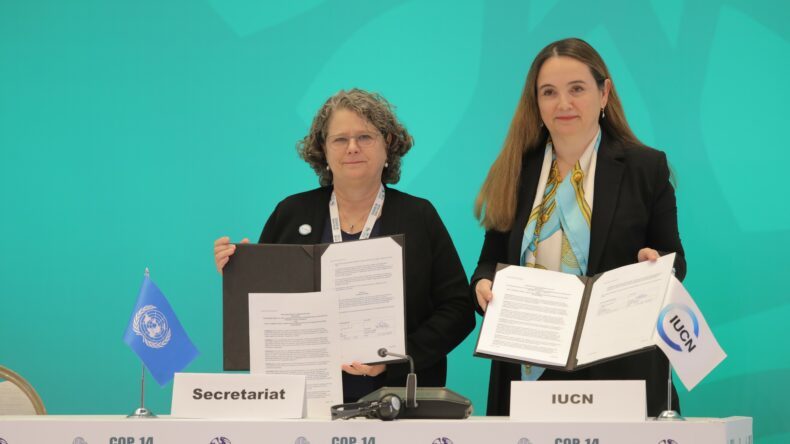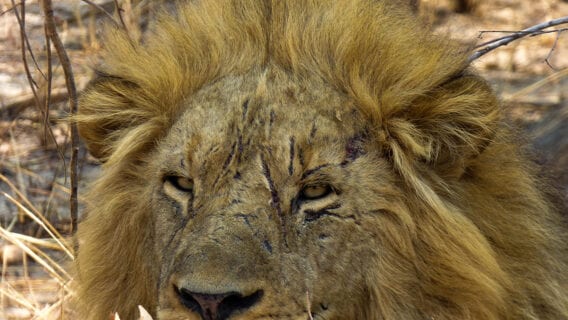IUCN at COP14: supporting species recovery to achieve global biodiversity goals

Launched during the opening of the COP, the CMS’ State of the World’s Migratory Species Report showed that 22% of CMS-listed species are threatened with extinction. The report stated that while some migratory species are improving, nearly half of CMS-listed species are showing population declines. Having long contributed data and expertise to the work of the CMS, IUCN welcomes this report and called on range states and CMS Parties to amplify individual and collective action to recover threatened migratory species, recognizing its importance to achieving many targets of the Global Biodiversity Framework, including ecosystem connectivity and integrity; equitably governed conservation areas; sustainable harvesting and trade of wild species; and creation of inclusive and sustainable economies.
Critical issues where IUCN contributed to the negotiations included the importance of a robust international framework and stronger protections against deep sea mining and bycatch of fisheries, which is driving many aquatic species into decline. IUCN and IUCN Species Survival Commission Specialist Groups also supported Single Species Action Plans for many threatened species: providing data and priorities for the development of plans and support to range states for actioning these. More broadly, IUCN contributed its expertise, data and tools on crosscutting conservation approaches: to support protected and conserved area management; integrate a One Health approach to combat wildlife disease and threats to human health; measures to enable safe migration of species; and prevent zoonotic disease outbreaks. Other topics discussed during COP14 present in the agenda covered the inclusion of Indigenous Peoples and Local Communities; integration of indigenous and local knowledge into conservation; and improving livelihood opportunities for local communities
To better protect threatened African carnivores, IUCN and the CMS Secretariat signed a memorandum of understanding (MOU) on February 13, 2024, to raise conservation funds and facilitate the implementation of the African Carnivore Initiative (ACI), a joint programme of work adopted by the CMS and the Convention on International Trade in Endangered Species of Wild Fauna and Flora (CITES) in 2021.
The decline in population numbers of key carnivore species in Africa (lions, cheetahs, leopards and African Wild Dogs) has been a major concern for range state parties in recent years. Habitat degradation, fragmentation, poaching and human-wildlife conflict are posing major threats to these apex predators, which are critical for healthy ecosystems. As part of this MOU, IUCN Save Our Species will work with the Secretariat of the CMS to raise funds and facilitate frontline conservation action targeted at protecting and recovering these four threatened species.
Elsewhere, IUCN Save Our Species hosted two side events during CMS COP14.
IUCN Species Conservation Action: A Global plan and financing mechanism to support implementation of CMS and the Global Biodiversity Framework demonstrated how IUCN’s Global Species Action Plan and conservation action portfolio is supporting stakeholders to achieve species recovery aligned with achieving the Global Biodiversity Framework (GBF). Participants heard from the IUCN Species Survival Commission on how the Plan can support governments to align species actions with GBF targets; and how countries such as the Republic of Korea are using GSAP to update its National Biodiversity Strategy and Action Plans to support species recovery. Turning to implementing conservation action, IUCN presented the IUCN Save Our Species programme, outlining the critical financing needs for conserving species and the role of partnerships between financial institutions, philanthropic, NGOs and others to bridge the financing gap.
Implementing the CMS Central Asian Mammals Initiative: Lessons and Plans from IUCN’s SOS Central Asia Initiative presented IUCN Save Our Species’ SOS Central Asia initiative, which supported the conservation of Vulnerable Snow and Goitered Gazelle populations in Kazakhstan, Kyrgyzstan and Tajikistan from 2019 to 2022. This initiative prioritised actions under CMS to engage local government, area managers and communities to maintain and restore key ecological corridors and reduce threats to one of the world’s last remaining migration hotspots.
By the end of CMS COP14, just like migratory species, its impacts and decisions did not adhere to political or geographical boundaries. Fourteen new species, subspecies, and populations were added to the CMS Appendices, including the Critically Endangered Balkan Lynx and the Vulnerable Lahille’s Bottlenose Dolphin. A total of four MOUs were signed between various countries and institutions, and COP14 also considered 52 agenda items benefiting migratory species under 25 different thematic groups. IUCN through its Species Survival Commission, Specialist Groups and conservation action initiatives will continue supporting the work of range states, CMS Parties and other stakeholders to strengthen, finance and implement species recovery.




